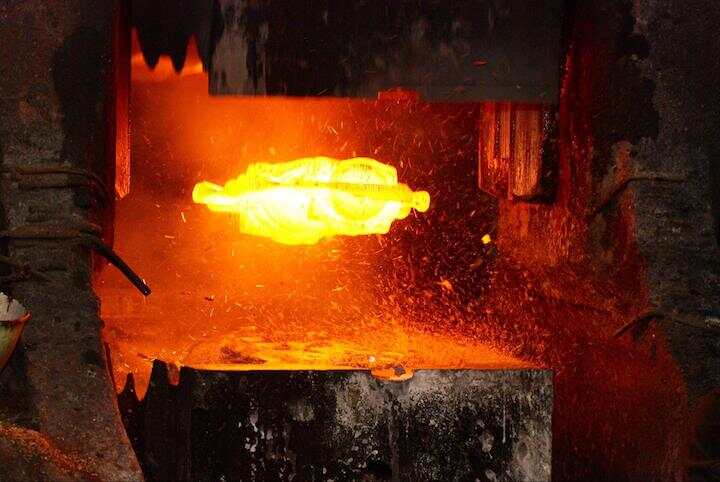Language
Currency


Hot forging is a widely used metalworking process that involves shaping metal at high temperatures. This technique has been employed for centuries, but its relevance and importance have only grown with advancements in technology and manufacturing. In this blog post,we will explore the key advantages of hot forging and why it remains a cornerstone in modern manufacturing, particularly in industries such as automotive, aerospace, and heavy machinery.
Improved Material Properties
Enhanced Strength and Ductility
One of the most significant advantages of hot forging is its ability to enhance the mechanical properties of metals.By heating the metal above its recrystallization temperature,hot forging refines the grain structure,resulting in increased strength and ductility.This process eliminates internal voids and defects,making the material more resilient and better able to handle stress and impact.For example,hot-forged steel components exhibit superior toughness and fatigue resistance,making them ideal for high-strength applications.
Reduced Internal Stresses
Hot forging reduces strain hardening and internal stresses that are common in cold forging processes.This reduction in internal stresses allows the material to be more malleable and easier to work with,resulting in fewer defects and improved overall product quality.The enhanced ductility also means that the metal can be shaped into more complex forms without cracking or breaking.
Efficient Production
Faster Shaping and Higher Production Rates
Heating the metal to high temperatures makes it more malleable,allowing for faster shaping and forming.This increased malleability means that hot forging can produce parts more quickly than cold forging,making it highly efficient for large-scale production runs.The process can achieve a production rate of 20 to 40 strokes per minute,which is significantly higher than other forging methods.
Cost-Effective for High-Volume Production
While the initial investment in dies and tooling for hot forging can be high,the process becomes economically viable for large production volumes.The ability to produce a large number of parts quickly and efficiently means that the cost per unit decreases as the production volume increases.This makes hot forging an ideal choice for industries that require a high volume of durable and high-performance components,such as automotive and aerospace.
Design Flexibility
Complex Shapes and Large Components
Hot forging allows for the production of complex shapes and large components that would be difficult or cost-prohibitive to produce using other manufacturing methods.The high temperatures and pressures used in hot forging enable the metal to flow into intricate dies,creating parts with detailed geometries.This design flexibility is particularly important in industries such as aerospace,where components often have complex shapes and must meet stringent performance requirements.
Near-Net-Shape Production
Hot forging can produce parts that are close to their final shape,reducing the need for extensive post-processing and machining.This near-net-shape production not only saves time and material but also reduces overall production costs.The ability to create parts with minimal material waste is especially beneficial in industries where material costs are high.
Enhanced Grain Structure
Uniformity and Refinement
The high temperatures used in hot forging allow for the refinement and uniformity of the metal's grain structure.This uniform grain structure results in improved mechanical properties,such as increased strength and toughness,throughout the entire component.The refined grain structure also enhances the material's resistance to fatigue and wear,making hot-forged parts more durable and long-lasting.
Improved Microstructure Control
While hot forging does not offer the same level of microstructure control as some other manufacturing processes,it still provides significant improvements over traditional forging methods.The ability to refine the grain structure and eliminate internal defects results in a more consistent and predictable material performance.This consistency is crucial for applications where reliability and performance are paramount.
Hot forging offers a range of advantages that make it an essential process in modern manufacturing.From improved material properties and efficient production to design flexibility and enhanced grain structure,hot forging provides significant benefits that are difficult to achieve with other manufacturing methods.While it may not be suitable for all applications,particularly those requiring high precision or complex geometries,hot forging remains a powerful and versatile technique for producing durable,high-performance metal components.As industries continue to demand stronger,more reliable,and more complex parts,hot forging will undoubtedly continue to play a vital role in meeting these needs.
Whether you are an engineer designing new components or a manufacturer looking to optimize your production processes,understanding the advantages of hot forging can help you make informed decisions and achieve your goals.By leveraging the power of hot forging,you can create products that are not only strong and durable but also cost-effective and efficient to produce.
Email cannot be empty
Password cannot be empty
Email format error
Email cannot be empty
Email already exists
6-20 characters(letters plus numbers only)
The password is inconsistent
Email format error
Email cannot be empty
Email does not exist
6-20 characters(letters plus numbers only)
The password is inconsistent